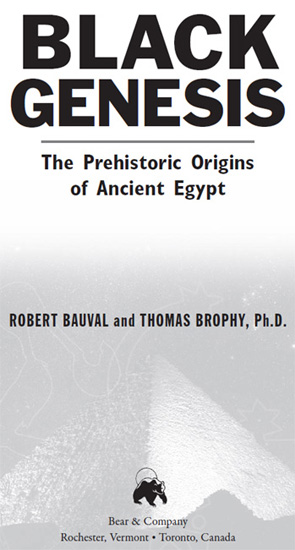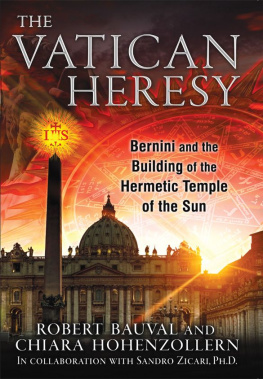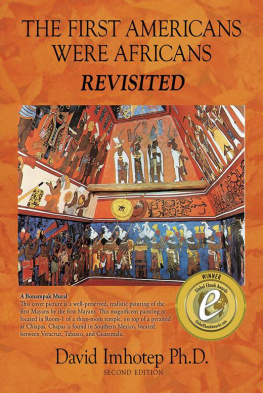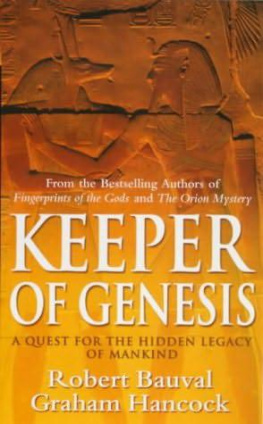
For my daughter, Candice, and my son, Jonathan.May you always remember your genesis.
Robert Bauval
To my parents, in deepest gratitude for bringing meinto this amazing journey.
Thomas Brophy
BLACK GENESIS
Black Genesis offers astounding new insights as Bauval and Brophy forcefully support, with hard data, the radical idea that Egyptian civilization was the outgrowth of a sophisticated Black African culture that existed thousands of years prior to the earliest known pharaohs. Their book is a must read for anyone interested in genuinely understanding the true origins of ancient Egypt and the dynamics of how civilizations develop.
ROBERT M. SCHOCH, PH.D.,AUTHOR OF VOYAGES OF THE PYRAMIDBUILDERS AND PYRAMID QUEST
Readers of Black Genesis will never think of ancient Egypt in the same way again. Bauval and Brophy make the case that this venerable civilization was originated by Black Africans from the Sahara Desert and that the pyramids, the statues, and the hieroglyphs were the result of their knowledge and ingenuity. The authors trace the series of errors and misjudgments that have obscured the origins of this remarkable civilization. It is time for the record to be set straight, and Black Genesis is the book that may well do it. This is an authoritative, excellent, well-written book.
STANLEY KRIPPNER, PH.D.,PROFESSOR OF PSYCHOLOGY AT SAYBROOK UNIVERSITY AND COAUTHOR OF PERSONAL MYTHOLOGY
In Black Genesis, Bauval and Brophy combined their investigative skills to answer an obvious but often-neglected question, Who were the ancient Egyptians? With new astroarchaeological evidence they build a strong case for The African origin of the pharaohs and have dramatically altered our understanding of the past.
ANTHONY T. BROWDER, AUTHOR AND INDEPENDENT EGYPTOLOGIST
ACKNOWLEDGMENTS
This book was not an easy one to research and to put together due to the vast and complex issues involved as well as the need to organize and undertake deep desert expeditions to the Egyptian Sahara. Yet with perseverance, dedication, and enthusiasm, we plodded on, step-by-step, page-by-page, and we can now say that we are extremely proud and pleased with the result.
As always, our first thanks go to our respective families. Their support, love, and patience are greatly appreciated. We wish to pay special thanks and tribute to anthropologists Fred Wendorf and Romuald Schild of the Combined Prehistoric Expedition for opening the way to the study of Nabta Playa. We also thank astronomer Kim Malville for being the first to realize the importance of the megalithic alignments at Nabta Playa. Special thanks go to longtime colleague and friend Paul Rosen whose combination of scientific integrity and complete lack of bias or dogmatism has supplied immeasurably helpful collaboration. Thanks, too, to the Jet Propulsion Laboratory of Pasadena, California, for supporting the unusual project of further studies of Nabta Playa.
Our thanks and respect is also due to the desert explorers Mark Borda and Carlo Bergmann for their many discoveries in the Egyptian Sahara and for their kind efforts to share some of these with us. We also thank Mahmoud Marai for guiding us to the remote locations of Gilf Kebir and Jebel Uwainat and showing us the wonderful rock-art cave and the hieroglyphic inscriptions discovered at Uwainat in 2007. We extend thanks to our friend and desert guide Mahmoud (Tiger) Nemr and geologist and desert guide Diaa Shehata for taking us safely to Nabta Playa, and we thank our friend Michael Ackroyd for delivering us to Nabta Playa in 2003 with necessary permits and with great panache. We thank Chance Gardner and Vanesse McNiel for making the fine graphic animations of the Calendar Circle.
Our thanks also go to the many colleagues and friends who, directly or indirectly, have helped us put this book together: Linda and Max Bauval; Hoda and Camille Hakim-Taraboulsi; Sherif el Sebai of Tarot Travel Tours; Gouda Fayed; Angela Richards; Brian Hokum; Lyra Marble; Dustin Donaldson; John and Josette Orphanidis; Jean-Paul and Pauline Bauval; June and Jim Brophy; Geoffrey and Therese Gauci; Richard (Fuzzy) Fusniak; Ambassador Jean Paul Tarud-Kuborn and his lovely wife, Valentina Troni; William Horsman and Viviane Vayssieres; the lovely family of my late driver, Mahmoud El Kirsh; Arianna Mendo; Robert Schoch; John Anthony West; Lily Lee; the Helios family (you know who you are!); Khaled el Bary, owner of the wonderful Barys Restaurant at the pyramids; Giulio Gallo; Mayumi Hashiyama; Carmen Boulter; and many others too numerous to name here, but who surely know that we are grateful for their friendship and support. We also thank our publisher, Inner Traditions, the lovely Cecilia Perugia at Corbaccio Edizione in Milan, and everyone at A. M. Heath Ltd. Last but definitely not least, we give thanks for having so many wonderful readers around the world who make all our efforts worthwhile.
INTRODUCTION
ANCIENT EGYPT REBORN
No colors any more I want them to turn black...
MICK JAGGER AND KEITH RICHARDS, PAINT IT BLACK, 1966
This book is the product of a deep and strong desire to use the best of our intellect, knowledge, and abilities to put right an issue that has long beleaguered historians and prehistorians alike: the vexed question of the Black African origins of the ancient Egyptian civilization. In spite of many clues that have been in place in the past few decades, which strongly favor a Black African origin for the pharaohs, many scholars and especially Egyptologists have either ignored them, confused them, or, worst of all, derided or scorned those who entertained them. It is not our business to know whether such an attitude is a form of academic racism or simply the blindered way of looking at evidence to which some modern Egyptology has become accustomed, but whatever the cause, this issue has remained largely unresolved.
We first came across this inherent bias and prejudice against African origins of the Egyptian civilization in the debatemore of an auto-daf reallyagainst the Black African professor Cheikh Anta Diop, who, in 1954, published his thesis Nation Ngre et Culture, which argued a Black African origin for the Egyptian civilization. Anta Diop was both an eminent anthropologist and a highly respected physicist, and as such, he was armed with an arsenal of cutting-edge science as well as the use of the latest technology in radiocarbon dating and biochemistry to determine the skin color of ancient mummies and corpses by analyzing their content of melanin, a natural polymer that regulates pigmentation in humans. Yet in spite of his careful scientific approach, the Egyptian authorities refused to provide Anta Diop with skin samples of royal mummies, even though only minute quantities were required, and they pilloried and shunned him at a landmark symposium in Cairo in 1974 on the origins of ancient Egyptians. Diop died in 1986, his mission not fully accomplished. Fortunately, however, the debate on African origins was quickly taken up by Professor Martin Bernal, who, in 1987, published a three-volume opus, Black Athena, that flared even further the already-heated debate. Bernal, a professor emeritus of Near Eastern studies at Cornell University, was the grandson of the eminent Egyptologist Sir Alan Gardiner, yet this did not prevent Egyptologists from attacking him with even more vehemence than they had his Black African predecessor Anta Diop.
Even though there is still much controversy surrounding the origins of the ancient Egyptian civilization, we can now say with much evidence-driven conviction that its origins have their genesis with a Black African people who inhabited the Sahara thousands of years before the rise of the pharaonic civilization. In this book we present hard scientific evidence and cogent arguments that have been culled from the latest findings and discoveries made in the Egyptian Sahara during the past four decades. We have consulted the publications of eminent anthropologists, paleoanthropologists, paleoclimatologists, paleopathologists, genetic scientists, archaeologists, archaeoastronomers, geologists, and even reports from daring desert explorers such as Mark Borda, Carlo Bergmann, and Mahmoud Marai, who have all contributed to showing that this specific region of the world was the crucible of the ancient Egyptian civilization. In researching this book, we have used the best and latest research accredited to experts and scholars, and we have also provided extensive notes in order for the reader to trace this source material for further reading. In addition, we have specifically used our own tool kit and method, which entails the application of the science of astronomy to interpret the alignments of complex megalithic structures, pyramids, and temples, as well as extracting the astronomical content in ancient Egyptian texts and tomb drawings. To phrase it another way, we have coaxed the silent, ancient stones to reveal their secrets with the universal language of the sky.
Next page





